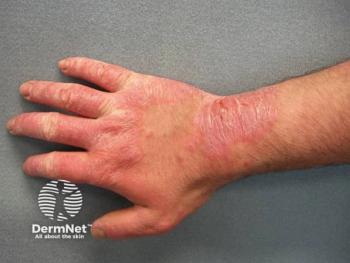
Emerging Insights into Apremilast’s Efficacy for Early Oligoarticular Psoriatic Arthritis Across BMI Spectrums
Key Takeaways
- Apremilast significantly reduces swollen and tender joint counts in early oligoarticular PsA, especially in weight-bearing joints, across all BMI categories.
- The phase 3 FOREMOST study highlights apremilast's clinical benefits over placebo, with sustained improvements through 48 weeks.
Apremilast improved joint symptoms and quality of life in patients with early oligoarticular PsA, with consistent efficacy across all BMI categories.
A recent poster presented at the Society of Dermatology Physician Associates (SDPA) Annual Summer Dermatology Conference spotlighted findings on the efficacy of apremilast (Otezla; Amgen Inc), an oral phosphodiesterase 4 inhibitor, in treating patients with early oligoarticular psoriatic arthritis (PsA), especially those with weight-bearing joint involvement.1
Oligoarticular PsA is characterized by the involvement of relatively few joints and can significantly impact patients’ quality of life despite its limited joint counts.2 Recognizing that body mass index (BMI) can influence disease activity and treatment response, the investigators aimed to explore whether apremilast’s benefits extend across different weight categories.
The phase 3 FOREMOST study (
Researchers performed subgroup analyses based on BMI categories: less than 25 kg/m2 (normal weight), 25 to less than 30 kg/m2 (overweight), and 30 kg/m2 or higher (obese).
Across all BMI groups, apremilast demonstrated significant clinical advantages over placebo. Patients treated with the drug experienced reductions in swollen and tender joint counts at week 16. These improvements were sustained through the 48-week follow-up.
At week 16, apremilast-treated patients demonstrated an overall mean 1.1 reduction in swollen joint count compared to a mean 0.1 in patients in the placebo group. When broken up into BMI categories, patients with a BMI < 25 exhibited a mean 1.3 reduction in swollen count count by week 16 versus 1.0 with placebo. In the cohort ranging from a BMI of 25 to < 30, apremilast-treated patients yielded a mean reduction of 1.3 (versus 0) at week 16. In the BMI ≥ 30 group, apremilast-treated patients had a 1-point reduction by week 16 versus 0 with placebo.
Furthermore, patient-reported outcomes highlighted notable improvements in overall daily functioning and well-being. Health Assessment Questionnaire-Disability Index scores improved more significant in patients treated with apremilast, regardless of BMI. Fatigue also decreased significantly, in line with improved quality of life scores from tools such as the SF-36 survey and PsAID-12. Even in patients with higher BMIs, apremilast maintained its beneficial effects.
The data presented in the poster supports apremilast's efficacy in early oligoarticular PsA involving weight-bearing joints, offering clinically meaningful symptom relief regardless of a patient’s BMI.
Moving forward, clinicians are encouraged to consider individual patient factors, including BMI, when designing comprehensive management strategies aimed at improving both joint health and quality of life for patients with PsA.
References
- Callis Duffin K, Mrowietz U, Merola JF, et al. Apremilast efficacy in patients with early oligoarticular psoriatic arthritis (PsA) affecting weight-bearing joints by body mass index (BMI): results from the randomized, double-blind, placebo-controlled FOREMOST study. Poster presented at: Society of Dermatology Physician Associates (SDPA) 2025 Annual Summer Dermatology Conference; June 26-29, 2025; Washington, DC.
- Marchesoni A. Oligoarticular psoriatic arthritis: addressing clinical challenges in an intriguing phenotype. Rheumatol Ther. 2018;5(2):311-316.
doi:10.1007/s40744-018-0115-5 - Completed efficacy, safety, and tolerability study of apremilast to treat early oligoarticular psoriatic arthritis (FOREMOST). ClinicalTrials.gov. Updated October 22, 2024. Accessed June 26, 2025.
https://clinicaltrials.gov/study/NCT03747939
Make sure to keep up to date with the latest in coverage from the conference and subscribe to Dermatology Times to receive daily email updates .
Newsletter
Like what you’re reading? Subscribe to Dermatology Times for weekly updates on therapies, innovations, and real-world practice tips.



















